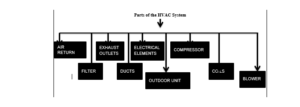The full form of HVAC is Heating Ventilation and Air Conditioning. The idea of HVAC originated in the middle of the 1800s. The inventor of HVAC, Dr John Gorrie came up with the idea of cooling cities during the temperature rising months. With the use of cooling coils, He designed a system which could control humidity. He secured a copyright for the device he invented and then planned to modify it into an automatic humidity and temperature control system.
Origin
As it is known that a little spark of fire is enough to let the forest burn down into ashes. Similarly, in the positive sense, the idea of Dr John Gorrie was modified and taken off at the Saint Louis’ World Fair in 1904 when a refrigeration system was built to cool the Missouri State Building. It was the first time that a building of public property had this feature. The idea was widespread even more when the public theatres too had the cooling and heating systems in them.
Though the idea was widespread, it was quite expensive for private use back then. So, H.H. Schultz and J.Q. Sherman invented a system in 1932 which could fit in window sills leading to HVAC systems with central air conditioning in most homes by the 1960s.
It is quite surprising when we use the concealed HVAC built into a unit of our homes leading to quieter heating and cooling with better designed features at just the switch of a button.
HVAC
HVAC is now the most important part of almost every residential structure like nuclear family homes, apartments, offices, industries, factories, hotels, skyscrapers, hospitals and vehicles like cars, trains , aeroplanes, ships, etcetera. The design of the HVAC system is a sub discipline of mechanical engineering. Being based on the principles of fluid mechanics, heat transfer and thermodynamics, the goal of HVAC is to provide acceptable indoor air quality and thermal comfort.
Providing heating and cooling from residential to commercial buildings, the HVAC systems contribute environmental comfort by using fresh air from outside to deliver high indoor air quality.
Ventilation is the process of substituting air within a space which provides a better quality of air indoors and removes moisture, smoke, heat, dust, odour, airborne microorganisms, carbon dioxide and other gases along with controlled temperature and recovery of oxygen. Thus, keeping the indoor air circulating, it prevents quiescence of the interior air.
Being used in both domestic and commercial environments, HVAC systems provide ventilation and mention pressure relationships between spaces within suitable installation, operation and maintenance cost. The process of delivery of fresh air and removal of stagnant air within the spaces is called the room air distribution.
Role of HVAC
The origin of the ventilation cycle is the air return part of the HVAC system. It sucks in air and passes through a filter which is then released into the main system. The filters must be frequently dusted as debris and dust easily build up on them.
Being the second part of the air return, the filter draws in the stagnated air. So, filters need to be regularly changed in order to keep the system running smoothly.
The exhaust created by the heating system is thrown out through the exhaust outlets. The hot or cool air passes through the channels called the ducts which need to be cleaned every 2 to 5 years to keep it running in a proper working condition.
Most often the problems originate in the electrical elements of the system. So, one must always check for a tripped breaker or dead batteries in the thermostat. The outdoor unit houses the fan which helps in the flow of air. The role of the compressor is to convert refrigerant from a gas into liquid and pass it to the coils which in turn cools the air as it passes through with the help of the refrigerant.
Features of HVAC
Heaters are those devices which are used to generate heat or warmth for a particular area which can be done with the help of central heating. It contains a boiler furnace for a heat pump to heat water steam or air in a central location like a furnace room at a home or a mechanical room in a large building. The heat transfer is done either by convection or conduction or radiation.
The purpose of the delivery of outside air into the building’s indoor space is one of the most important factors for maintaining acceptable indoor air quality through the process of ventilation.
ASHRAE sought to advance heating, ventilation, air conditioning and refrigeration systems. The full form of ASHRAE is the American Society of Heating, Refrigerating and Air-conditioning Engineers. ASHRAE funds research projects and offers continuing education programs in order to develop and publish technical standards for improving building services engineering, energy efficiency, indoor air quality and sustainable development. ASHRAE was founded in the year 1894 at a meeting of engineers in New York City. Its goal is to shape tomorrow’s-built environment today.
Conclusion
With the increasing population, the needs have arisen drastically. So, the natural resources are getting depleted as well in order to fulfil the individual needs. Hence, HVAC is responsible to nurture energy efficiency of buildings for the building sector absorbs the highest percentage of global energy.
ISHRAE was established to uphold the HVAC industry in India. The full form of ISHRAE is the Indian Society of Heating, Refrigerating and Air Conditioning Engineers which was founded at New Delhi in the year 1981.
 Profile
Profile Settings
Settings Refer your friends
Refer your friends Sign out
Sign out




